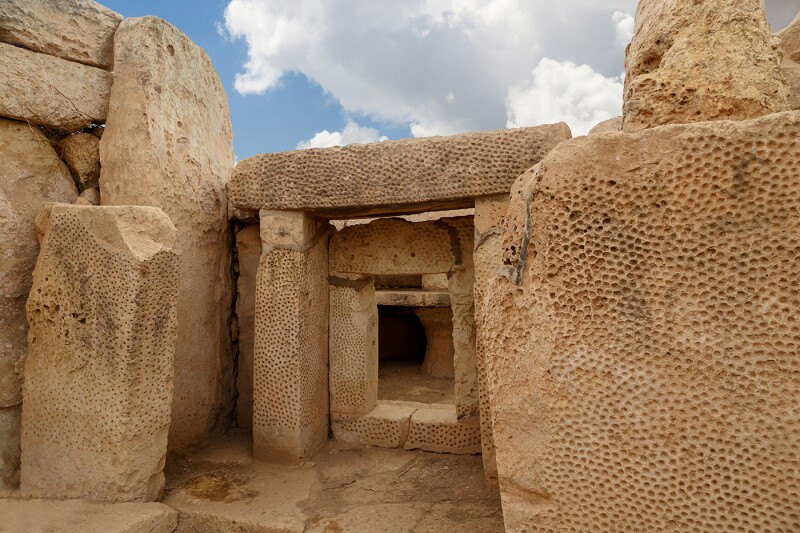The islands of Malta have a higher density of UNESCO World Heritage sites than any other nation-state. Many are in the city of Valletta, which was named a European Capital of Culture in 2018. Whether built for ceremonial purposes in Neolithic times or to stave off military invasions during the 16th century, these sites provide remarkable displays of preserved history.
Fort Ricasoli
Built by the Knights of Malta in the late 16th century to protect the harbor from land and naval attacks, the largely intact Fort Ricasoli is now closed to the public and only used by the Malta Film Commission for period movies like Gladiator and Troy. Back in 2000, director Ridley Scott set his infamous fight scene here, recreating a third of the Colosseum from plaster and plywood at a cost of $1 million. And in 2004, the fort was used to build the entire city of Troy from the ground up covering 10 acres. Parts of the fort were also used to depict the Red Keep in the first season of the HBO series Game of Thrones.
Fort Saint Elmo

Fort Saint Elmo was built in the late Middle Ages but played an important role in World War II.
Photo by Alexander Ingerman/Shutterstock
Despite having been built in the late Middle Ages, Fort Saint Elmo didn’t earn its name until 1850, when it was used as British army barracks. The fort also played an important role in World War II, when the Italians launched an attack on the Grand Harbour, and it now houses Malta’s National War Museum and the Malta Police Academy. It’s used for historical reenactments, educational purposes, outdoor movie screenings, and a film set. The fort served to depict a prison in the 1978 Oliver Stone classic Midnight Express and famously doubled as Marseilles in 2002’s The Count of Monte Cristo. More recently, its courtyard was filled with undead masses for Brad Pitt’s zombie drama World War Z.
Mdina

The fortified city of Mdina served as King’s Landing in an episode of “Game of Thrones.”
Photo by Shutterstock
The fortified city of Mdina was the capital of Malta before the arrival of the Order of Saint John, after which it remained an important—but quiet—place, eventually earning the nickname “the Silent City.” Architecturally, the pedestrian-only town, which can be explored in a few hours, features limestone walls covered in bright bougainvillea, as well as both baroque and medieval facades. In fact, its ornate main gate and moat bridge were featured as King’s Landing in season one, episode three of Game of Thrones (when Catelyn and Rodrik arrive to find out what happened to Bran).
Hagar Qim and Mnajdra Temples

The Hagar Qim temple is made from several megaliths that weigh nearly 20 tons.
Photo by Shutterstock
Designated UNESCO World Heritage sites, these two Stonehenge-like structures date back to 3600–3200 B.C.E. but were only excavated in 1839. Both are accessed via the same visitor center, where for €10 you’ll get a ticket and a comprehensive (and highly recommended) audio guide to listen to, as you wander through the small museum and Neolithic temples. While both sites are referred to as temples, it’s still a bit of a mystery as to what, exactly, went on within them, making a visit here feel somewhat eerie. The first building, Hagar Qim, features several megaliths weighing nearly 20 tons that make up different apses, or rooms. Further down a long, narrow road toward the sea sits Mnajdra, where a doorway and decorated blocks mark the position of the rising sun on the autumnal and vernal equinoxes, as well as the summer and winter solstices. Give yourself at least two hours to properly experience the buildings.
Saint Paul’s Church, Grotto, and Catacombs

Dozens of burial chambers make up the 21,000-square-foot Saint Paul Catacombs.
Photo by Anca Popa/Shutterstock
Located on the outskirts of Mdina in Rabat, Saint Paul’s Church and Grotto pay homage to the great Paul the Apostle, who, along with 274 others, was shipwrecked just off Malta around 60 C.E. on his way to Rome. Legend has it that he and the other survivors took refuge in a grotto, above which a church and monument were later built in his honor. A few miles away, the catacombs, which represent the earliest evidence of Christianity in Malta, are a labyrinthian set of underground cemeteries that feel like something straight out of Indiana Jones and the Temple of Doom. Covering an area of more than 21,000 square feet, they twist and turn with dozens of hypogea (chambers) once used for burials. It’s a great place to wander on a hot day because it’s cool underground—and only €5 to visit.
>>Next: Plan Your Trip With AFAR’s Travel Guide to Malta











